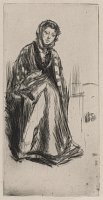The Scotch Widow | ||
| Number: | 147 | |
| Date: | 1875/1876 | |
| Medium: | drypoint | |
| Size: | 205 x 103 mm | |
| Signed: | butterfly at right | |
| Inscribed: | no | |
| Set/Publication: | 'Cancelled Plates', 1879 | |
| No. of States: | 1 | |
| Known impressions: | 18 | |
| Catalogues: | K.142; M.140; W.118 | |
| Impressions taken from this plate (18) | ||
TECHNIQUE
The Scotch Widow is pure drypoint.
PRINTING
Only three impressions of The Scotch Widow before cancellation have been located. They were printed in black ink, two on ivory laid paper, one with a foolscap watermark ( ), the other with a 'DEDB' and beehive watermark (
), the other with a 'DEDB' and beehive watermark ( ); the other impression is on thin off-white Japanese paper (
); the other impression is on thin off-white Japanese paper ( ). The drypoint lines printed with a rich burr.
). The drypoint lines printed with a rich burr.
 ), the other with a 'DEDB' and beehive watermark (
), the other with a 'DEDB' and beehive watermark ( ); the other impression is on thin off-white Japanese paper (
); the other impression is on thin off-white Japanese paper ( ). The drypoint lines printed with a rich burr.
). The drypoint lines printed with a rich burr.It was published in an album of Cancelled Plates ('Cancelled Set') by The Fine Art Society, London, 1879. At least 20 impressions - possibly as many as 24 - were printed from the cancelled plate (i.e.  ). They were printed in black ink, but are faint, with very little burr remaining.
). They were printed in black ink, but are faint, with very little burr remaining.
 ). They were printed in black ink, but are faint, with very little burr remaining.
). They were printed in black ink, but are faint, with very little burr remaining.
